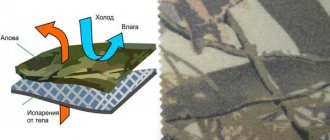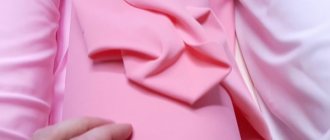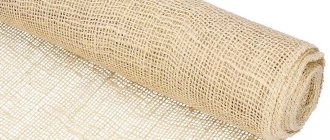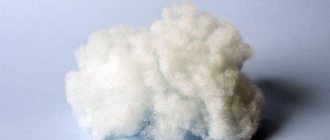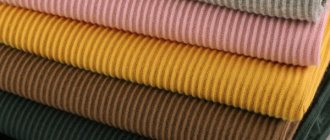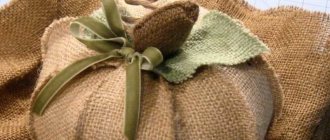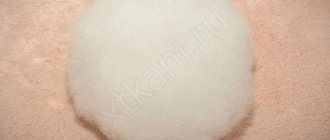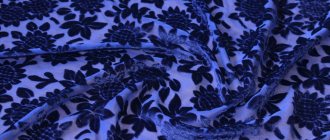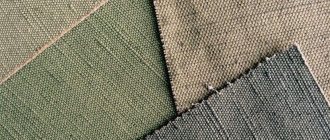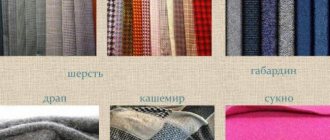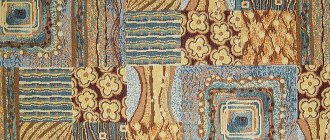Workwear is an invariable attribute of representatives of some professions. Due to the fact that specialists wear such products throughout the entire working day, the requirements for the material are quite high. In addition to an attractive appearance, the fabric for a uniform must be of high quality, safe, wear-resistant, and practical. Mixed materials meet these criteria, one of which is tissi. The synthetic and natural fibers included in its composition, as well as various weaving techniques, make it possible to combine the advantages of both types of raw materials? Thereby minimizing operational disadvantages.
Features and characteristics of the fabric, description of the material
Tisi (TS, TiSi, T/S, TC Poplin) is a thin, pleasant to the touch, but slightly rough fabric with a noticeable interweaving of fibers, reminiscent of natural linen. It is produced in all sorts of colors - the cuts can be plain or decorated with some kind of print. This material will tell you about a blanket for a bed in a sea-green bedroom.
The texture of the fabric allows the application of logos, signs, emblems, so it is in great demand among enterprises for which the appearance of employees is of no small importance.
The composition is represented by two components - polyester (about 65% specific weight) and natural cotton (35%). Sometimes, in addition to cotton, viscose or tencel is added to the fabric. At the same time, there are no strictly limited limits in the production of this material - the manufacturer is free to independently decide how many natural and artificial fibers will be included in its products. The density of the material directly depends on the composition - the more synthetics, the higher it is (and the price of such fabric is lower). But most often on the market you can find tissi with a density of 110-240 g/m², but if it is treated with a special impregnation, then the average density is about 160 g/m². Read about tulle mesh and its use in the interior at this link.
Information about the composition of the matter is on the label - if you carefully study it, you will notice something like “T/C65/35/165”. This code means: “TC, 65% polyester, 35% cotton, density – 165 g/m².
The composition of the material determines its following properties:
- ease;
- strength;
- resistance to high temperatures;
- breathability;
- shape and color stability;
- antistatic;
- resistance to mechanical stress;
- hypoallergenic.
Due to the fact that the fabric does not wrinkle and gets dirty slowly, the owner of things made from it always looks neat.
Advantages and disadvantages
Tissi makes products that are comfortable, lightweight and attractive in appearance. Other advantages include:
- pleasant sensations upon contact with the skin;
- variety of colors;
- no shrinkage after washing or drying;
- budget.
A mixed fabric impregnated with a special water-repellent substance does not absorb water, repels dirt and dust, and does not form stains (which is especially appreciated by medical workers).
The disadvantages of the material are associated with the large number of synthetic fibers in the composition - such clothes will be hot in the summer, but cold in the winter. Read about the elasticated bedspread and bed cover here.
Due to the lack of elasticity, only straight styles with a loose fit are available, which do not fit the figure, which can be a disadvantage for some fashionistas.
Production: how to get it
The main suppliers of matter are South Korea and China. There are two methods for making such textiles:
- Interweaving of fibers of various compositions. With this method, the resulting fabric has the properties of both natural and synthetic components, and the appearance from the back and front sides is no different.
- The twill method, in which a scar is formed on the surface of the fabric, directed diagonally. In this weave, dissimilar fibers are used, as a result of which one side of the fabric turns out to be synthetic, and the other - natural.
Disadvantages of the material
The material is used mainly for sewing corporate clothing. It is inconvenient to wear constantly, since a large percentage is synthetic. The tissi-blend fabric has a high density and is hot in summer.
And yet, there are more advantages. If you are interested specifically in materials for clothing, we recommend that you look at the section of the site that talks about them. You will find a lot of information.
Manufacturers offer different types of products. For example, medical tissi fabric, in addition to moisture resistance, also has the property of repelling dirt, including blood. For the same reason, tissi shirt fabric, which does not absorb sweat, is widely used. If you are interested in popular textile news, read the article about Lacoste material. It will surprise you even more with its properties and characteristics.
Varieties
Depending on the final purpose of the tissi, the following types are distinguished:
- Shirt Lux-120 – fabric with plain weave, density 120 g/m². It is treated with water-repellent impregnation. It can be plain or with patterns and emblems. It is used as a lining material for jackets, outerwear, as well as for sewing uniforms for medical institutions or food industry enterprises.
- Shirt Lux-150 is a thinner and, accordingly, cheaper analogue of the previous type.
- Raincoat - the composition includes 80% polyester and only 20% cotton. Designed for the manufacture of outerwear, as well as uniforms for law enforcement officers.
- Sonata is a material that always comes with a quality certificate. It features a high cotton content (45%).
It is used for sewing workwear for doctors or laboratory workers, catering workers, and representatives of the service sector.
Composition and production technology
Sisu fabric, described above, is a mixture of natural and artificial raw materials. The optimal ratio of materials in tissi is considered to be 35% cotton and 65% polyester, but manufacturers often try to reduce the cost of the fabric by “shifting” the proportions. A common ratio is 20% cotton to 70% polyester.
If necessary, the fabric is additionally treated with water-repellent impregnations so that it better resists dirt and specific liquids (for example, blood and other organics).
You might be interested in this All about jacquard: detailed description of the fabric
The material is woven with plain weave threads. The surface is rough, with clearly visible weaving. When using twill weaving, a fabric with a diagonal rib is obtained.
The surface of the fabric is uneven, rough, but pleasant to the touch
Scope of application: what is sewn from fabric
The characteristics of the fabric allow it to be used in many areas. Uniforms for workers are made from yew:
- medical institutions, various laboratories;
- food industry enterprises;
- canteens, bars, cafes, restaurants;
- hotels, hotels;
- cleaning companies;
- security organizations;
- companies specializing in advertising.
Clothes lined with a durable, waterproof yew lining are valued among hunters and fishermen. You can often see military personnel and firefighters wearing uniforms made from this material.
Care
Products made from TC are machine washable at 40 °C. Bleaching agents are not used if colored finishes are used. The colors can be varied, from bright plain-dyed fabric to a printed pattern.
You can iron from the wrong side.
If you need a fabric that combines high hygienic indicators and good physical and mechanical properties, and also does not require special care.
You should definitely pay attention to TC.
© 2021 textiletrend.ru
Recommendations for caring for fiber products
Caring for items made from mixed fabrics, such as Boston and boucle, will not cause much trouble. Washing is carried out both manually and by machine, the water temperature should be 35-40 ºС. Since the material is not prone to excessive contamination, any detergent can be used - universal powders or gels will easily remove all stains that have formed. Read about Turkish bamboo towels here.
Iron things from the inside out, setting the iron to “synthetic” or “nylon” mode.
The only thing you should avoid is bleaches, which are only suitable for white fabrics. Products can be wrung out and dried in any convenient way. Workwear with water-repellent impregnation tolerates boiling well.
How to care for this textile
The main difference between tissi fabric is its low maintenance:
- You can wash things by hand or in a washing machine in the “Synthetic fabric” mode. It is important that the temperature is not higher than +40 degrees. Any washing powder will do, but it is not recommended to use bleach, especially with chlorine, unless it is a white item.
Important! Clothing intended for medical workers and people who work with food undergoes special treatment at the fabric production stage; it can be boiled and processed.
Caring for fabric is simple: tissue does not require specific knowledge or skills
- There are no requirements for drying, but if desired, it is worth straightening the item in advance, before drying, to make it easier to iron.
- You can iron this fabric in the “synthetic” mode from the inside out. If the clothing has an emblem appliqué, it can only be ironed from the inside.
Medical cap
Otherwise, there are no problems with the fabric.
TC fabric is a blend of cotton and polyester. Thanks to the optimal combination of natural and synthetic parts, tissi is used in sewing workwear and uniforms for medical staff, workers in the food and service sectors.
Which fabric is better: Tisi or Satori
Satori fabric can compete with tissi. This is a mixed material that is most often used in sewing uniforms for doctors, cosmetologists, cooks, and waiters. The advantage of this type is its composition, which is half cotton. This ensures not only strength, but also softness of the product, good heat transfer, breathability, and high absorbent properties. Satori can be washed using bleach or disinfectants. The main disadvantage of satori is the cost, which is significantly higher compared to less natural tisi. Read about an orthopedic sleeping pillow in this article.
The lower the specific gravity of synthetic components, the more such characteristics as strength, service life, and resistance to stains suffer. Therefore, the choice of material for workwear depends on the direction of its further use, as well as the financial capabilities of the buyer.
Features you need to know about
The characteristics of tissi fabric are based on its composition. Let's name the following:
- Increased service life (unlike natural analogues);
- Easy to care for (thanks to polyester);
- Lightweight and hygienic (thanks to cotton);
- Antistatic (clothes are not electrified).
Very comfortable, light, beautiful things. The products are modern and meet all requirements. Company logos, emblems are applied to it, and painted in the desired color. The body does not sweat, as the degree of breathability is high.
Reviews
Galina: As a worker in the sanitary department at a city hospital, I can say for sure: TC is the best fabric for doctors’ clothing. Even the heaviest blood stains can be easily washed off, and after boiling things look like new!
Oleg: In the restaurant where I work, they gave me a uniform made of the same fabric as described in the article. Of course, it’s comfortable, it’s beautiful, but it only gets hot for the fast-moving waiter.
Masha: As a seamstress, I will say one thing: sewing anything from yew is a pleasure.
Properties
Thanks to the combined composition of tissi fabric, it has a number of properties, both positive and negative.
pros
- Breathability due to the cotton content of the fabric.
- Durable due to the large percentage of polyester fibers in the composition.
- Does not wrinkle, shrink or stretch due to the main synthetic content.
- Resistant to moisture, dust and dirt.
- Nice appearance.
- The paint is securely fixed in the fibers of the fabric and does not fade over time.
- The material is easy to care for. It is easy to wash and, if dried properly, does not require ironing.
- Affordable price.
- The fabric is easy to sew and makes working with it a pleasure.
Minuses
- It does not stretch, which is why it is impossible to sew tightly fitting items from it.
- Due to the high synthetic content, tissi clothes will be hot in summer.
- The fabric is not able to retain heat, so it is not suitable for winter clothes.
Application
TC is great for sewing attractive clothing for workers in various fields. The fabric does not wrinkle, any dirt can be easily washed off, and the bright color retains its original appearance for a long time. So what specific clothes and what else are they sewing from TC?
- Medical gowns and suits are made of thin fabric, and jackets for doctors are made of thicker raincoat fabric. You can often hear the answer to the question what is tissi fabric, that it is a fabric for doctors. This is true, because even the most complex stains in the form of blood can be easily washed off. The fabric can also be boiled. This is especially important in the medical field and food industry, where complete sterility is required.
- Clothes for service personnel in restaurants and hotels are practical, comfortable and presentable at the same time.
- Employees of hairdressing and beauty salons often purchase work clothes made from tissi because they are not only comfortable, but also beautiful.
- Workwear for workers at construction sites and in other areas where high-quality, long-lasting and durable clothing is needed.
